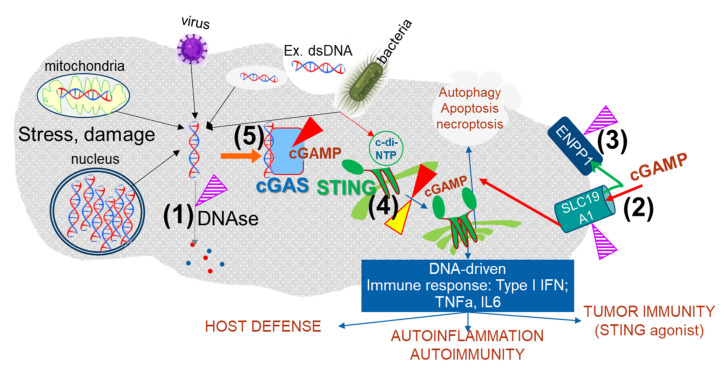Figure 1.
An increase in dsDNA in the cytosol can be the result of bacterial or viral infections. The entry of extracellular (ex.) DNA via endosomes results in the escape of partially digested DNA to the tightly controlled different DNAses, whose expression might vary from cell to cell. Bacteria might also activate the pathway by bypassing cGAS since cyclic dinucleotides produced by bacteria have been shown to bind to STING: cGAS (blue) is activated when cytosolic DNA is increased, and it synthetizes cGAMP. After binding cGAMP (red), STING dimerizes/multimerizes (green) and promotes the transcription of many cytokines belonging to the IFN type I family. The DNA-driven immune response is responsible for tumor immunity and plays a pivotal role in autoinflammation and autoimmunity. The cGAS/STING pathway can be modulated at different sites. Inhibition of the DNAses (1), the cGAMP transporters (shown using the example of SLC19A1) (2), or the cGAMP degrading enzymes ENPP1 (3) results in the increased activity of the pathway. Based on the current experience in drug discovery, it is unlikely that we will ever find low molecular weight compounds capable of stimulating at (1), (2), and (3); therefore, “inhibition” (violet-striped triangles) is to be considered the only therapeutic option. Using STING agonists (yellow triangle) (4) is the other option considered for activating the pathway. The activation of the cGAS/STING pathway has been shown to have a large potential for fighting tumors but might also be valuable in cases where a strong transient increase of the IFN response could help fight viral infection. Inhibition of the cGAS/STING pathway can be achieved with cGAS (5) or STING (4) specific inhibitors (red triangle). This intervention might be relevant for many autoinflammatory diseases that show an increase in IFN type I response. Evidence suggests that the cGAS/STING pathway controls autophagy and it has a role in apoptosis/necrosis. The relevance of these branches of the cGAS/STING pathway for their potential role in disease pathology is currently not well understood.

